Reflecting the Effect of Physical–Perceptual Components on Increasing the Anxiety of Inner-City Rail Transit’s Users: An Integrative Review
Abstract
1. Introduction
- Public transportation significantly impacts citizens’ emotions, behaviors, and cognitive and physiological symptoms of anxiety.
- The physical–perceptual components commonly associated with train stations influence the relationship between citizens’ anxiety levels and the overall performance of the public transportation system.
- Q-1: What are the physical–perceptual indicators associated with public transportation?
- Q-2: Which indicators have the potential to elevate anxiety levels among urban train users?
2. Literature Review
2.1. Citizens’ Anxiety in Public Space and Transportation
2.2. The Common Components of Public Transportation Systems
2.3. Relationship Between Public Transportation and Anxiety
2.4. The Role of Shared Mobility Systems in Alleviating Citizens’ Anxiety
3. Materials and Methods
4. Results
4.1. Theories on Urban Transport from 1860 to 1910
4.2. Theories on Urban Transport from 1930 to 1970
4.3. Theories on Urban Transport from 1980 to the Present
- Personalization strategies
- Policy
- Perception
- Fear
- Stress
- Safety
- Anxiety
- Shared mobility
- Management
- Micromobility
- Metro
- Rail Transit
- Accessibility
- Lighting
- Signage
5. Discussion
6. Conclusions
Author Contributions
Funding
Institutional Review Board Statement
Informed Consent Statement
Data Availability Statement
Acknowledgments
Conflicts of Interest
References
- Thompson, S. Introduction to happiness and society. In Oxford Handbook of Happiness; OUP Oxford: London, UK, 2013. [Google Scholar]
- Bhugra, D.; Ventriglio, A.; Castaldelli-Maia, J.; McCay, L. (Eds.) Urban Mental Health, illustrated ed.; Oxford University Press: London, UK, 2019. [Google Scholar]
- Harrison, G.A. Urbanization and stress. In Disease and Urbanization; Routledge: Oxford, UK, 2022; pp. 55–72. [Google Scholar]
- Altwaijri, Y.A.; Al-Subaie, A.S.; Al-Habeeb, A.; Galea, S.; Akkad, M.; Naseem, M.T.; Bilal, L. Urbanization and mental health: A perspective from Riyadh City, Kingdom of Saudi Arabia. Int. J. Soc. Psychiatry 2023, 69, 1121–1133. [Google Scholar] [CrossRef] [PubMed]
- Sahadevan, V.; Mathews, A.J. A conceptual study in understanding the critical impact of urbanisation towards mental health of the individuals. Quest. J. 2023, 11, 268–272. [Google Scholar]
- Avila-Palencia, I.; Panis, L.I.; Dons, E.; Gaupp-Berghausen, M.; Raser, E.; Götschi, T.; Gerike, R.; Brand, C.; de Nazelle, A.; Orjuela, J.P.; et al. The effects of transport mode use on self-perceived health, mental health, and social contact measures: A cross-sectional and longitudinal study. Environ. Int. 2018, 120, 199–206. [Google Scholar] [CrossRef]
- Tsoi, K.H.; Loo, B.P. A people-environment framework in evaluating transport stress among rail commuters. Transp. Res. Part D Transp. Environ. 2023, 121, 103833. [Google Scholar] [CrossRef]
- Lan, Y.; Roberts, H.; Kwan, M.-P.; Helbich, M. Transportation noise exposure and anxiety: A systematic review and meta-analysis. Environ. Res. 2020, 191, 110118. [Google Scholar] [CrossRef] [PubMed]
- Dong, H.; Ma, S.; Jia, N.; Tian, J. Understanding public transport satisfaction in post COVID-19 pandemic. Transp. Policy 2021, 101, 81–88. [Google Scholar] [CrossRef]
- Campisi, T.; Basbas, S.; Al-Rashid, M.A.; Tesoriere, G.; Georgiadis, G. A region-wide survey on emotional and psychological impacts of COVID-19 on public transport choices in Sicily, Italy. Trans. Transp. Sci. 2021, 12, 34–43. [Google Scholar] [CrossRef]
- Conceição, M.A.; Monteiro, M.M.; Kasraian, D.; Berg, P.E.W.v.D.; Haustein, S.; Alves, I.; Azevedo, C.L.; Miranda, B. The effect of transport infrastructure, congestion and reliability on mental wellbeing: A systematic review of empirical studies. Transp. Rev. 2023, 43, 264–302. [Google Scholar] [CrossRef]
- Iamtrakul, P.; Chayphong, S.; Hayashi, Y. An Integrative Investigation of Travel Satisfaction, Streetscape Perception, and Mental Health in Urban Environments. Sustainability 2024, 16, 3526. [Google Scholar] [CrossRef]
- De Nisco, A.; Warnaby, G. Urban design and tenant variety influences on consumers’ emotions and approach behavior. J. Bus. Res. 2014, 67, 211–217. [Google Scholar] [CrossRef]
- Kilian, B. Anxious City: The Fears and Apprehensions of Citizens and Tourists in Modern Urban Areas. In Urban Amazement; Wydawnictwo Uniwersytetu Śląskiego: Katowice, Poland, 2015. [Google Scholar]
- Cheng, Y.-H. Exploring passenger anxiety associated with train travel. Transportation 2010, 37, 875–896. [Google Scholar] [CrossRef]
- Mansilla, J.C.; Boucher, N.; Routhier, F. Public Transport in the Disabling City: A Narrative Ethnography of Dilemmas and Strategies of People with Mobility Disabilities. Disabilities 2024, 4, 228–261. [Google Scholar] [CrossRef]
- Meyer, M.D. Transportation Planning Handbook; Institute of Transportation Engineers: Washington, DC, USA, 2016. [Google Scholar]
- Meenar, M.; Flamm, B.; Keenan, K. Mapping the Emotional Experience of Travel to Understand Cycle-Transit User Behavior. Sustainability 2019, 11, 4743. [Google Scholar] [CrossRef]
- Yang, L.; van Dam, K.; Zhang, L. Developing Goals and Indicators for the Design of Sustainable and Integrated Transport Infrastructure and Urban Spaces. Sustainability 2020, 12, 9677. [Google Scholar] [CrossRef]
- Ravazzoli, E.; Torricelli, G.P. Urban mobility and public space. A challenge for the sustainable liveable city of the future. J. Public Space 2017, 2, 37–50. [Google Scholar] [CrossRef]
- Martiskainen, M.; Sovacool, B.K. Mixed feelings: A review and research agenda for emotions in sustainability transitions. Environ. Innov. Soc. Transit. 2021, 40, 609–624. [Google Scholar] [CrossRef]
- Raj, J.; Shetty, N.V. Consumer Perception on public transport. Aegaeum J. 2021, 9, 204–221. [Google Scholar]
- Li, L.; Gao, T.; Yu, L.; Zhang, Y. Applying an integrated approach to metro station satisfaction evaluation: A case study in Shanghai, China. Int. J. Transp. Sci. Technol. 2021, 11, 780–789. [Google Scholar] [CrossRef]
- Ratering, C.; Van Der Heijden, R.; Martens, K. Moving around with an anxiety disorder. Transp. Res. Part F Traffic Psychol. Behav. 2024, 100, 493–506. [Google Scholar] [CrossRef]
- Currie, G. Handbook of Public Transport Research; Edward Elgar Publishing Limited: Gloucester, UK, 2021. [Google Scholar]
- Alawad, H.; An, M.; Kaewunruen, S. Utilizing an Adaptive Neuro-Fuzzy Inference System (ANFIS) for Overcrowding Level Risk Assessment in Railway Stations. Appl. Sci. 2020, 10, 5156. [Google Scholar] [CrossRef]
- Nations, U. World Cities Report 2020: The Value of Sustainable Urbanization; United Nations Human Settlements Programme: Nairobi, Kenya, 2020. [Google Scholar]
- WHO. Urban Green Spaces and Health; World Health Organization, Regional Office for Europe: Geneva, Switzerland, 2016. [Google Scholar]
- Litman, T. Evaluating Public Transportation Health Benefits; Victoria Transport Policy Institute: Victoria, BC, Canada, 2012. [Google Scholar]
- Evans, G.W.; Wener, R.E. Crowding and personal space invasion on the train: Please don’t make me sit in the middle. J. Environ. Psychol. 2007, 27, 90–94. [Google Scholar] [CrossRef]
- Garg, R.; Muhammad, S.N.; Cabassa, L.J.; McQueen, A.; Verdecias, N.; Greer, R.; Kreuter, M.W. Transportation and other social needs as markers of mental health conditions. J. Transp. Health 2022, 25, 101357. [Google Scholar] [CrossRef]
- Desai, P.; Kelly, J.; Sykes, W. Passengers’ Perceptions of Personal Security on Public Transport: Qualitative Research Report; Department for Transport: London, UK, 2010.
- Kim, J.; Gustafson-Pearce, O. Passengers’ anxiety about using the London Underground. In Proceedings of the 2016 IEEE International Conference on Intelligent Rail Transportation (ICIRT), Birmingham, UK, 23–25 August 2016. [Google Scholar]
- Jacobs, M. Feel safe, be safe on public transport. Public Transp. Int. 1996, 45, 69–71. [Google Scholar]
- Li, Z.; Hensher, D.A. Crowding and public transport: A review of willingness to pay evidence and its relevance in project appraisal. Transp. Policy 2011, 18, 880–887. [Google Scholar] [CrossRef]
- Plutchik, R. The Nature of Emotions: Human emotions have deep evolutionary roots, a fact that may explain their complexity and provide tools for clinical practice. Am. Sci. 2001, 89, 344–350. [Google Scholar] [CrossRef]
- Clark, D.A.; Beck, A.T. The Anxiety and Worry Workbook: The Cognitive Behavioral Solution, 2nd ed.; Guilford Publications: New York, NY, USA, 2011. [Google Scholar]
- Hope, D.A.; Heimberg, R.G.; Turk, C.L. Managing Social Anxiety, Workbook: A Cognitive-Behavioral Therapy Approach; Oxford University Press: London, UK, 2019. [Google Scholar]
- Kovács, T.Z.; Nábrádi, A.; Tóth, S.; Huzsvai, L.; Nagy, A.; Bittner, B. Sustainable Public Transportation in a Volatile, Uncertain, Complex, and Ambiguous (VUCA) Age. Sustainability 2023, 15, 15310. [Google Scholar] [CrossRef]
- Hidalgo-Muñoz, A.R.; Jallais, C.; Evennou, M.; Fort, A. Driving anxiety and anxiolytics while driving: Their impacts on behaviour and cognition behind the wheel. Heliyon 2023, 9, e16008. [Google Scholar] [CrossRef] [PubMed]
- McCay, L.; Bremer, I.; Endale, T.; Jannati, M.; Yi, J. Urban Design and Mental Health. In Mental Health and Illness in the City; Springer: Singapore, 2017; pp. 1–24. [Google Scholar]
- Roe, J.; McCay, L. Restorative Cities: Urban Design for Mental Health and Wellbeing, 1st ed.; Bloomsbury Academic: London, UK, 2021. [Google Scholar]
- Joshi, A.; Nagar, A.K.; Marín-Raventós, G. Sustainable Intelligent Systems; Springer: Singapore, 2021. [Google Scholar]
- Chen, C.L.; Pan, H.; Shen, Q.; Wang, J.J. Handbook on Transport and Urban Transformation in China; Edward Elgar Publishing: Cheltenham, UK, 2020. [Google Scholar]
- Mohd Mahudin, N.D.; Cox, T.; Griffiths, A. Measuring rail passenger crowding: Scale development and psychometric properties. Transp. Res. Part F Traffic Psychol. Behav. 2012, 15, 38–51. [Google Scholar] [CrossRef]
- Rezapour, M.; Richard Ferraro, F. The impact of commuters’ psychological feelings due to delay on perceived quality of a rail transport. Humanit. Soc. Sci. Commun. 2021, 8, 190. [Google Scholar] [CrossRef]
- Soto, J.; Orozco-Fontalvo, M.; Useche, S.A. Public transportation and fear of crime at BRT Systems: Approaching to the case of Barranquilla (Colombia) through integrated choice and latent variable models. Transp. Res. Part. A Policy Pract. 2022, 155, 142–160. [Google Scholar] [CrossRef]
- Ahmad Nazrul Hakimi, I.; Muhamad Nazri, B.; Nur Izzi Md., Y.; Amiruddin, I. Rail-based Public Transport Service Quality and User Satisfaction—A Literature Review. Promet Traffic Transp. 2020, 32, 435–447. [Google Scholar]
- Pyrgidis, C.N. Railway Transportation Systems: Design, Construction and Operation; Taylor & Francis Group: Boca Raton, FL, USA, 2018. [Google Scholar]
- Luna-Cortés, G. Stress perceived by foreigners that use public transportation in Bogotá (Colombia). Res. Transp. Econ. 2020, 80, 100811. [Google Scholar] [CrossRef]
- Tirachini, A.; Hensher, D.A.; Rose, J.M. Crowding in public transport systems: Effects on users, operation and implications for the estimation of demand. Transp. Res. Part A Policy Pract. 2013, 53, 36–52. [Google Scholar] [CrossRef]
- Mahudin, N.M.; Cox, T.; Griffiths, A. Modelling the spillover effects of rail passenger crowding on individual well being and organisational behaviour. WIT Trans. Built Environ. 2011, 116, 227–238. [Google Scholar]
- Kim, H. Service design for public transportation to address the issue of females’ fear of crime. Transportation 2019, 48, 167–192. [Google Scholar] [CrossRef]
- Cozens, P.; Neale, R.; Hillier, D.; Whitaker, J. Tackling Crime and Fear of Crime While Waiting at Britain’s Railway Stations. J. Public Transp. 2004, 7, 23–41. [Google Scholar] [CrossRef]
- Wang, Y.; Guo, J.; Currie, G.; Ceder, A.; Dong, W.; Pender, B. Bus Bridging Disruption in Rail Services With Frustrated and Impatient Passengers. IEEE Trans. Intell. Transp. Syst. 2014, 15, 2014–2023. [Google Scholar] [CrossRef]
- Currie, G.; Muir, C. Understanding Passenger Perceptions and Behaviors During Unplanned Rail Disruptions. Transp. Res. Procedia 2017, 25, 4392–4402. [Google Scholar] [CrossRef]
- Mouratidis, K. Bike-sharing, car-sharing, e-scooters, and Uber: Who are the shared mobility users and where do they live? Sustain. Cities Soc. 2022, 86, 104161. [Google Scholar] [CrossRef]
- Roblek, V.; Meško, M.; Podbregar, I. Impact of Car Sharing on Urban Sustainability. Sustainability 2021, 13, 905. [Google Scholar] [CrossRef]
- Shaheen, S.; Cohen, A.; Zohdy, I. Shared Mobility: Current Practices and Guiding Principles; US Federal Highway Administration: Washington, DC, USA, 2016.
- Machado, C.A.S.; de Salles Hue, N.P.M.; Berssaneti, F.T.; Quintanilha, J.A. An overview of shared mobility. Sustainability 2018, 10, 4342. [Google Scholar] [CrossRef]
- Zhou, F.; Zheng, Z.; Whitehead, J.; Perrons, R.K.; Washington, S.; Page, L. Examining the impact of car-sharing on private vehicle ownership. Transp. Res. Part A Policy Pract. 2020, 138, 322–341. [Google Scholar] [CrossRef]
- Okeke, O.B. The impacts of shared autonomous vehicles on car parking space. Case Stud. Transp. Policy 2020, 8, 1307–1318. [Google Scholar] [CrossRef]
- Dolins, S. Diagnosing Sharing Anxiety. Bachelor’s Thesis, Chalmers University of Technology, Gothenburg, Sweden, 2021. [Google Scholar]
- Shaheen, S.; Bansal, A.; Chan, N.; Cohen, A. Mobility and the sharing economy: Industry developments and early understanding of impacts. In Low Carbon Mobility for Future Cities: Principles and Applications; Transportation Sustainability Research Center: Berkeley, CA, USA, 2017. [Google Scholar]
- Nansubuga, B.; Kowalkowski, C. Carsharing: A systematic literature review and research agenda. J. Serv. Manag. 2021, 32, 55–91. [Google Scholar] [CrossRef]
- Fabra, N.; Pintassilgo, C.; Souza, M. Observed patterns of free-floating car-sharing use. SERIEs 2024, 15, 259–297. [Google Scholar] [CrossRef]
- Bridge, G. Perceptions of e-Micromobility Vehicles amongst Staff and Students at Universities in the North of England. Act. Travel Stud. 2023, 3, 1164. [Google Scholar] [CrossRef]
- Suel, E.; Xin, Y.; Wiedemann, N.; Nespoli, L.; Medici, V.; Danalet, A.; Raubal, M. Vehicle-to-grid and car sharing: Willingness for flexibility in reservation times in Switzerland. Transp. Res. Part D Transp. Environ. 2024, 126, 104014. [Google Scholar] [CrossRef]
- Schumacher, U.E. Digital Access System for Vehicles for Externally Controlled Loading Processes. U.S. Patent 1176214B2, 19 September 2023. [Google Scholar]
- Caballini, C.; Corazza, M.V.; Costa, V.; Delponte, I.; Olivari, E. Assessing the feasibility of MaaS: A contribution from three Italian case studies. Sustainability 2022, 14, 16743. [Google Scholar] [CrossRef]
- Guevara-Cedeño, J.; Villarreal, A.J.H.; Quintero, V.L. Flexible Electric Car Leasing System with Blockchain-based payment infrastructure. In Proceedings of the 2024 9th International Youth Conference on Energy (IYCE), Colmar, France, 2–6 July 2024. [Google Scholar]
- Terama, E.; Peltomaa, J.; Rolim, C.; Baptista, P. The contribution of car sharing to the sustainable mobility transition. Transfers 2018, 8, 113–121. [Google Scholar] [CrossRef]
- Reyes, J.; Cansino, J.M.; Román-Collado, R.; Mundaca, L. Car Sharing Services in Sweden and Spain: Market, Environmental and Behavioural Insights; Lund University: Lund, Sweden, 2020. [Google Scholar]
- Baptista, P.; Melo, S.; Rolim, C. Car sharing systems as a sustainable transport policy: A case study from Lisbon, Portugal. In Sustainable Urban Transport; Emerald Group Publishing Limited: Leeds, UK, 2015; pp. 205–227. [Google Scholar]
- Creutzig, F.; Franzen, M.; Moeckel, R.; Heinrichs, D.; Nagel, K.; Nieland, S.; Weisz, H. Leveraging digitalization for sustainability in urban transport. Glob. Sustain. 2019, 2, e14. [Google Scholar] [CrossRef]
- FORTH Empowering Mobility. The Future of Car Sharing: Electric, Affordable, and Community-Centered: The Community Electric Vehicle Project; FORTH Empowering Mobility: Portland, OR, USA, 2018. [Google Scholar]
- Lowson, R.; Townsend, J. Community Rail and Inclusive, Accessible Travel; Community Rail Network: Huddersfield, UK, 2023. [Google Scholar]
- Coleman, W.; Skinner, S. Beyond Traffic; US Department of Transportation: Washington, DC, USA, 2015.
- San, P.; Metropolitan, D.; Barnes, D.; Downey, M.; Llc, C.; Arndt, J.; Auten, J.; Avis, M.; Ballard, P.; Carrasco, A. Transportation Cooperative Research Program (TCRP). 2018. Available online: https://onlinepubs.trb.org/onlinepubs/tcrp/TCRPAnnual2018.pdf (accessed on 23 April 2025).
- International Carsharing Association. The Impact of Car Share Services in Australia; Phillip Boyle & Association: Melbourne, Australia, 2016. [Google Scholar]
- Wang, H.; Hurwitz, D.; Belz, N. Micromobility Promises and Challenges in the Pacific Northwest; United States Department of Transportation: Washington, DC, USA, 2022.
- Singh, V.; Soni, D.; Jayaraman, S. E-mobilizing India: Accelerating Sustainable Electric Mobility in Indian Cities; IDTP India: Chennai, India, 2022. [Google Scholar]
- POLIS. Catch Me if You Can! How European Cities Are Regulating Shared Micromobility. 2023. Available online: https://www.polisnetwork.eu/document/catch-me-if-you-can-micromobility-paper/ (accessed on 23 April 2025).
- International Transport Forum. Cognitive Impairment, Mental Health and Transport Design with Everyone in Mind: Design with Everyone in Mind; OECD Publishing: Paris, France, 2009. [Google Scholar]
- European Environment Agency. Environmental Noise in Europe; European Environment Agency: Copenhagen, Denmark, 2020.
- Sebastian, S. Crowd Management on Metro Station Platforms. Ph.D. Thesis, Centre for Transport Studies University College London, London, UK, 2018. [Google Scholar]
- Cooper, E.; Gates, S.; Grollman, C.; Mayer, M.; Davis, B.; Bankiewicz, U.; Khambhaita, P. Transport, Health, and Wellbeing: An Evidence Review for the Department for Transport; The Department for Transport: London, UK, 2019.
- Transport, D.f. Design Standards for Accessible Railway Stations; A Joint Code of Practice by the Department for Transport and Transport Scotland; Transport Scotland Comhdhail Alba: Glasgow, Scotland, 2015.
- John, A. Volpe National Transportation Systems Center. Transit Noise and Vibration Impact Assessment Manual; FTA Report No. 0123; Federal Transit Administration: Washington, DC, USA, 2018.
- Transportation Research Board. Transit Capacity and Quality of Service Manual, 3rd ed.; The National Academies Press: Washington, DC, USA, 2003. [Google Scholar]
- Evans, G.W.; Wener, R.E. Rail commuting duration and passenger stress. Health Psychol. 2006, 25, 408. [Google Scholar] [CrossRef] [PubMed]
- Wener, R.E.; Evans, G.W. Comparing stress of car and train commuters. Transp. Res. Part F Traffic Psychol. Behav. 2011, 14, 111–116. [Google Scholar] [CrossRef]
- Beirão, G.; Cabral, J.S. Understanding attitudes towards public transport and private car: A qualitative study. Transp. Policy 2007, 14, 478–489. [Google Scholar] [CrossRef]
- Haywood, L.; Koning, M.; Monchambert, G. Crowding in public transport: Who cares and why? Transp. Res. Part A Policy Pract. 2017, 100, 215–227. [Google Scholar] [CrossRef]
- ITF. Measuring New Mobility: Definitions, Indicators, Data Collection; International Transport Forum Policy Papers No. 114; OECD Publishing: Paris, France, 2023.
- Tyrinopoulos, Y.; Antoniou, C. Public transit user satisfaction: Variability and policy implications. Transp. Policy 2008, 15, 260–272. [Google Scholar] [CrossRef]
- Wisma, U.N.; Block, C.; Damansara, K.P.; Jalan, D.; Damansara, H. A Review of International Best Practice in Accessible Public Transportation for Persons with Disabilities; United Nations Development Programme: New York, NY, USA, 2010. [Google Scholar]
- United States Department of Transportation. National Transit Database Safety & Security Policy; Office of Budget and Policy: Washington, DC, USA, 2021.
- Shivanand, S.H. A Guidebook on Integrated Public Transport System; Center of Excellence in Urban Transport CRDF, CEPT University: Ahmedabad, India, 2023. [Google Scholar]
- Parnell, K.J.; Merriman, S.E.; Plant, K.L. Gender perspectives on electric micromobility use. Hum. Factors Ergon. Manuf. Serv. Ind. 2023, 33, 476–489. [Google Scholar] [CrossRef]
- Van Kasteren, A.; Vredenborg, M. Personalized, context-aware communication in multimodal public transport. In Proceedings of the 30th ACM Conference on User Modeling, Adaptation and Personalization, Barcelona, Spain, 4–7 July 2022. [Google Scholar]
- Bozkurt, S.; Uğursoy, A.S.; Meral, S.P. The Impact of Personalized Messages and Designs on Consumer Experiences and Marketing Communications in Technology: Hyper-Personalization. In Impact of Contemporary Technology on Art and Design; IGI Global: Hershey, PA, USA, 2025; pp. 135–164. [Google Scholar]
- Ueno, S.; Ohnishi, W.; Koseki, T. A proposal for a personalized trustable guidance system for urban railways considering passenger behavior attributes. Mech. Eng. J. 2023, 10, 22-00310. [Google Scholar] [CrossRef]
- You, L.; Hao, M.; Sun, J.; Wang, Y.; Rong, C.; Yuen, C.; Santi, P.; Ratti, C. Toward a personalized autonomous transportation system: Vision, challenges, and solutions. Innov. 2024, 5, 100704. [Google Scholar] [CrossRef]
- Zhang, Y.; Wildemuth, B.M. Qualitative Analysis of Content by. Hum. Brain Mapp. 2005, 30, 2197–2206. [Google Scholar]
- Roller, M.R.; Lavrakas, P.J. Applied Qualitative Research Design: A Total Quality Framework Approach; Guilford Publications: New York, NY, USA, 2015. [Google Scholar]
- Krippendorff, K.; Bock, M. The Content Analysis Reader; SAGE Publications, Inc.: Thousand Oaks, CA, USA, 2009. [Google Scholar]
- Berg, B.L. Qualitative Research Methods for the Social Sciences; Allyn & Bacon: Boston, MA, USA, 2001. [Google Scholar]
- Mayring, P. Qualitative Content Analysis. Forum Qual. Soc. Res. 2000, 1, 20. [Google Scholar] [CrossRef]
- Shava, G.; Hleza, S.; Tlou, F.; Shonhiwa, S.; Mathonsi, E. Qualitative Content Analysis, Utility, Usability and Processes in Educational Research. Int. J. Res. Innov. Soc. Sci. 2021, 5, 553–558. [Google Scholar]
- Creswell, J.W. Qualitative Inquiry and Research Design: Choosing Among Five Approaches, 2nd ed.; Sage Publications, Inc.: Thousand Oaks, CA, USA, 2007. [Google Scholar]
- UN-Habitat. SDG Project Assessment: Integrating Sustainability in Urban Transport; 2020; Available online: https://unhabitat.org/sites/default/files/2020/10/wcr_2020_report.pdf (accessed on 23 April 2025).
- Vuchic, V.R. Urban Transit Systems and Technology; John Wiley & Sons: New York, NY, USA, 2007. [Google Scholar]
- Qi, L.; Jia, L.; Luo, Y.; Chen, Y.; Peng, M. The External Characteristics and Mechanism of Urban Road Corridors to Agglomeration: Case Study for Guangzhou, China. Land 2022, 11, 1087. [Google Scholar] [CrossRef]
- Xu, J.; Yang, J.; Yao, L. Transportation Structure Analysis Using SD-MOP in World Modern Garden City: A Case Study in China. Discret. Dyn. Nat. Soc. 2012, 2012, 710854. [Google Scholar] [CrossRef]
- Coskun, H. Henri Prost’s Paris and Istanbul Plannings: Zoning Regulations as Urban Planning Tools: Housing, Green Areas, Parks, Axis. In Innovations in Green Urbanization and Alternative Renewable Energy; Springer: Cham, Switzerland, 2022; pp. 107–118. [Google Scholar]
- Clarke, N. Urban policy mobility, anti-politics, and histories of the transnational municipal movement. Prog. Hum. Geogr. 2012, 36, 25–43. [Google Scholar] [CrossRef]
- Frampton, K. Megaform as Urban Landscape. J. Delta Urban. 2021, 2, 12–23. [Google Scholar] [CrossRef]
- Dittmar, H.; Belzer, D.; Autler, G. An introduction to transit-oriented development. In The New Transit Town: Best Practices in Transit-Oriented Development; Island Press: Washington, DC, USA, 2004; pp. 1–18. [Google Scholar]
- Dudley, G.; Preston, J. Historical Narrative and the Evolution of Academic Transport Studies in the UK. Transp. Rev. 2013, 33, 131–147. [Google Scholar] [CrossRef]
- Hirt, S.A. Premodern, modern, postmodern? Placing new urbanism into a historical perspective. J. Plan. Hist. 2009, 8, 248–273. [Google Scholar] [CrossRef]
- Behrendt, F. Cycling the smart and sustainable city: Analyzing EC policy documents on internet of things, mobility and transport, and smart cities. Sustainability 2019, 11, 763. [Google Scholar] [CrossRef]
- Oswald, K.F. A brief history of smart transportation infrastructure. Transfers 2016, 6, 123–129. [Google Scholar] [CrossRef]
- Zantalis, F.; Koulouras, G.; Karabetsos, S.; Kandris, D. A review of machine learning and IoT in smart transportation. Future Internet 2019, 11, 94. [Google Scholar] [CrossRef]
- Wiedmann, F.; Schlosser, C. Urban Fabrics and the Future of Transport-Oriented Development in Gulf Cities. In Urban Challenges in the Globalizing Middle-East; Springer: Cham, Switzerland, 2021; pp. 153–169. [Google Scholar]
- Liu, J.; Liu, G.; Wang, Y.; Zhang, W. Artificial-intelligent-powered safety and efficiency improvement for controlling and scheduling in integrated railway systems. High Speed Railw. 2024, 2, 172–179. [Google Scholar] [CrossRef]
- Singh, P.; Dulebenets, M.A.; Pasha, J.; Gonzalez, E.D.R.S.; Lau, Y.-Y.; Kampmann, R. Deployment of autonomous trains in rail transportation: Current trends and existing challenges. IEEE Access 2021, 9, 91427–91461. [Google Scholar] [CrossRef]
- van der Werf, I. Changing the mindset: How public transport can become more user centered. In Towards User-Centric Transport in Europe: Challenges, Solutions and Collaborations; Springer: Cham, Switzerland, 2019; pp. 105–117. [Google Scholar]
- Canale, S.; Di Giorgio, A.; Lisi, F.; Panfili, M.; Celsi, L.R.; Suraci, V.; Priscoli, F.D. A future internet oriented user centric extended intelligent transportation system. In Proceedings of the 2016 24th Mediterranean Conference on Control and Automation (MED), Athens, Greece, 21–24 June 2016. [Google Scholar]
- López-Aguilar, P.; Batista, E.; Martínez-Ballesté, A.; Solanas, A. Information security and privacy in railway transportation: A systematic review. Sensors 2022, 22, 7698. [Google Scholar] [CrossRef]
- Chowdhury, S.; Van Wee, B. Examining women’s perception of safety during waiting times at public transport terminals. Transp. Policy 2020, 94, 102–108. [Google Scholar] [CrossRef]
- Dolins, S.; Strömberg, H.; Wong, Y.Z.; Karlsson, M. Sharing anxiety is in the driver’s seat: Analyzing user acceptance of dynamic ridepooling and its implications for shared autonomous mobility. Sustainability 2021, 13, 7828. [Google Scholar] [CrossRef]
- Martinez, L.M.; Pritchard, J.P.; Crist, P. Shared Mobility’s Role in Sustainable Mobility: Past, Present, and Future. Annu. Rev. Environ. Resour. 2024, 49, 191–222. [Google Scholar] [CrossRef]
- Muskan. Investigating Role of Range Anxiety in Electrification of Shared Mobility. In Annual Conference on Infrastructure and Built Environment: Towards Sustainable and Resilient Societies; Springer: Singapore, 2023. [Google Scholar]
- Chen, X.; Deng, H.; Guan, S.; Han, F.; Zhu, Z. Cooperation-oriented multi-modal shared mobility for sustainable transport: Developments and challenges. Sustainability 2024, 16, 11207. [Google Scholar] [CrossRef]
- Li, X.; Wang, Y.; Tang, J.; Shi, L.; Zhao, T.; Chen, J. Emotional wellbeing in intercity travel: Factors affecting passengers’ long-distance travel moods. Front. Public Health 2022, 10, 1046922. [Google Scholar] [CrossRef]
- Zhang, X.; Liu, D.; Wang, Y.; Du, H. Behavioral Intentions of Urban Rail Transit Passengers during the COVID-19 Pandemic in Tianjin, China: A Model Integrating the Theory of Planned Behavior and Customer Satisfaction Theory. J. Adv. Transp. 2021, 2021, 8793101. [Google Scholar] [CrossRef]
- Stjernborg, V. Triggers for feelings of insecurity and perceptions of safety in relation to public transport; the experiences of young and active travellers. Appl. Mobilities 2024, 1–21. [Google Scholar] [CrossRef]
- APTA (Bus Rapid Transit Working Group). Apta Standards Development Program; American Public Transportation Association: Washington, DC, USA, 2010. [Google Scholar]
- Chowdhury, S.; Patel, P.; Giridharan, V.; Ceccato, V. Formation of fear and adaptive behavior in young ethnic minority women riding public transport. Transp. Res. Rec. 2024, 2678, 687–697. [Google Scholar] [CrossRef]
- Wang, B.; Zacharias, J. Noise, odor and passenger density in perceived crowding in public transport. Transp. Res. Part A Policy Pract. 2020, 135, 215–223. [Google Scholar] [CrossRef]
- Shao, J. Design for the Emotion Management: Research on urban rail transit voice broadcasting system based on Bio-signal. In Proceedings of the 2023 8th International Conference on Intelligent Computing and Signal Processing (ICSP), Xi’an, China, 21–23 April 2023. [Google Scholar]
- Heo, J.; Kozaki, M.; Koga, T.; Hirate, K.; Kim, H.B. Comprehensive evaluation of the visual environment of a railroad station’s platform, focused on the user’s psychology. Appl. Sci. 2021, 11, 6566. [Google Scholar] [CrossRef]
- Salat, S.; Ollivier, G. Transforming the Urban Space Through Transit-Oriented Development: The 3V Approach; World Bank: Washington, DC, USA, 2017. [Google Scholar]
- Gehl, J. Cities for People; Island Press: Washington, DC, USA, 2013. [Google Scholar]
- Cervero, R.; Kockelman, K. Travel demand and the 3Ds: Density, diversity, and design. Transp. Res. Part D Transp. Environ. 1997, 2, 199–219. [Google Scholar] [CrossRef]
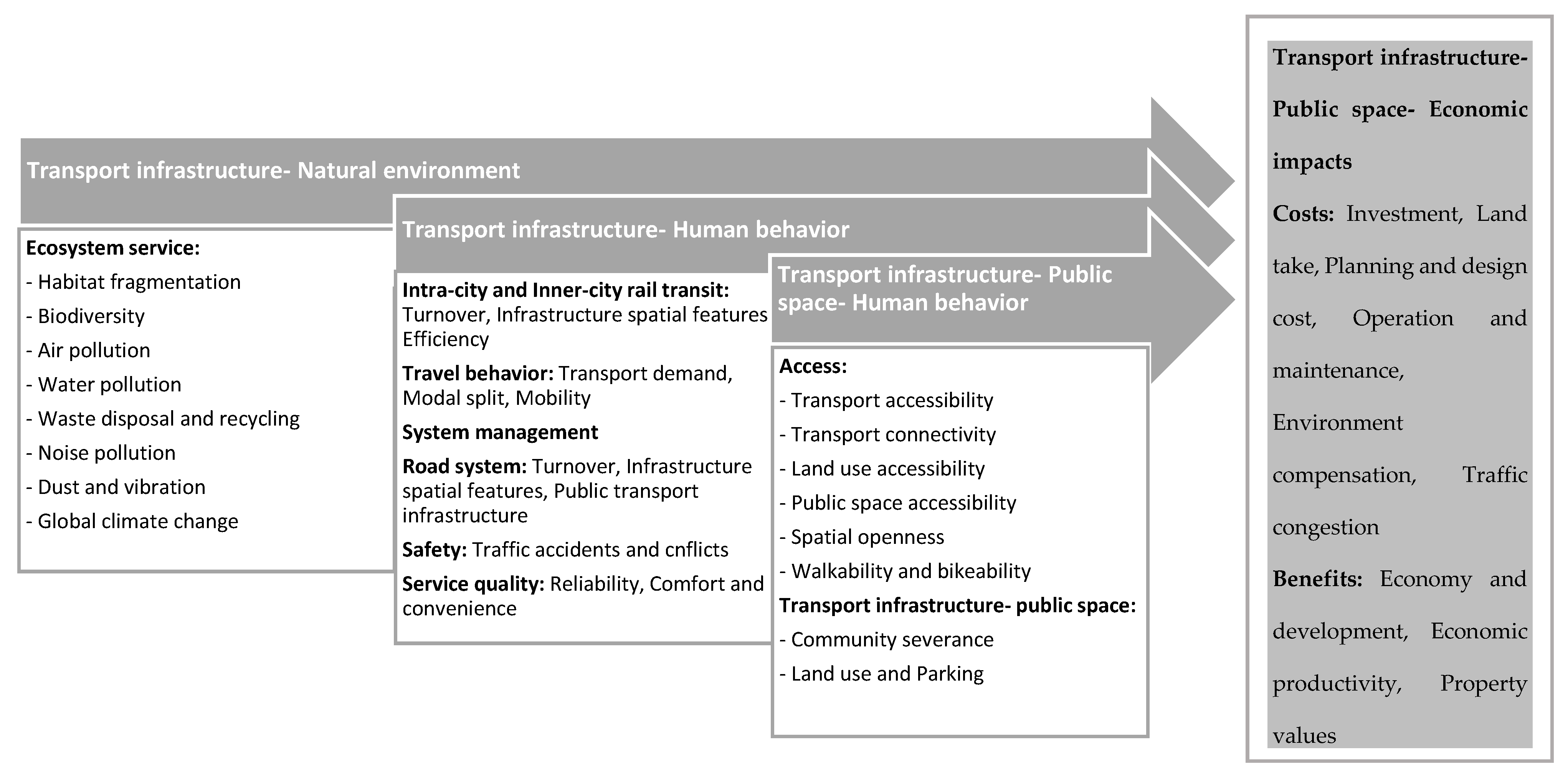
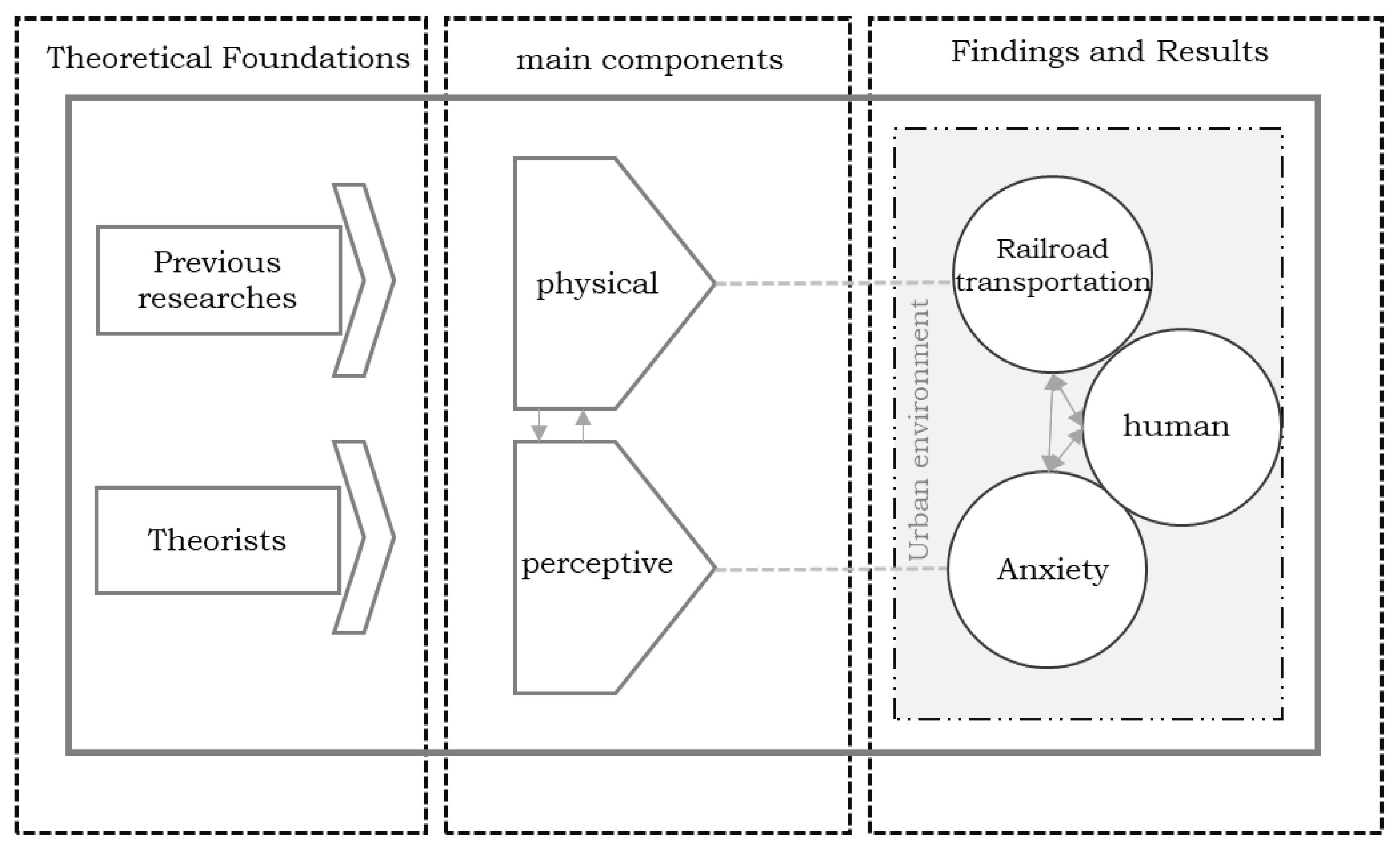


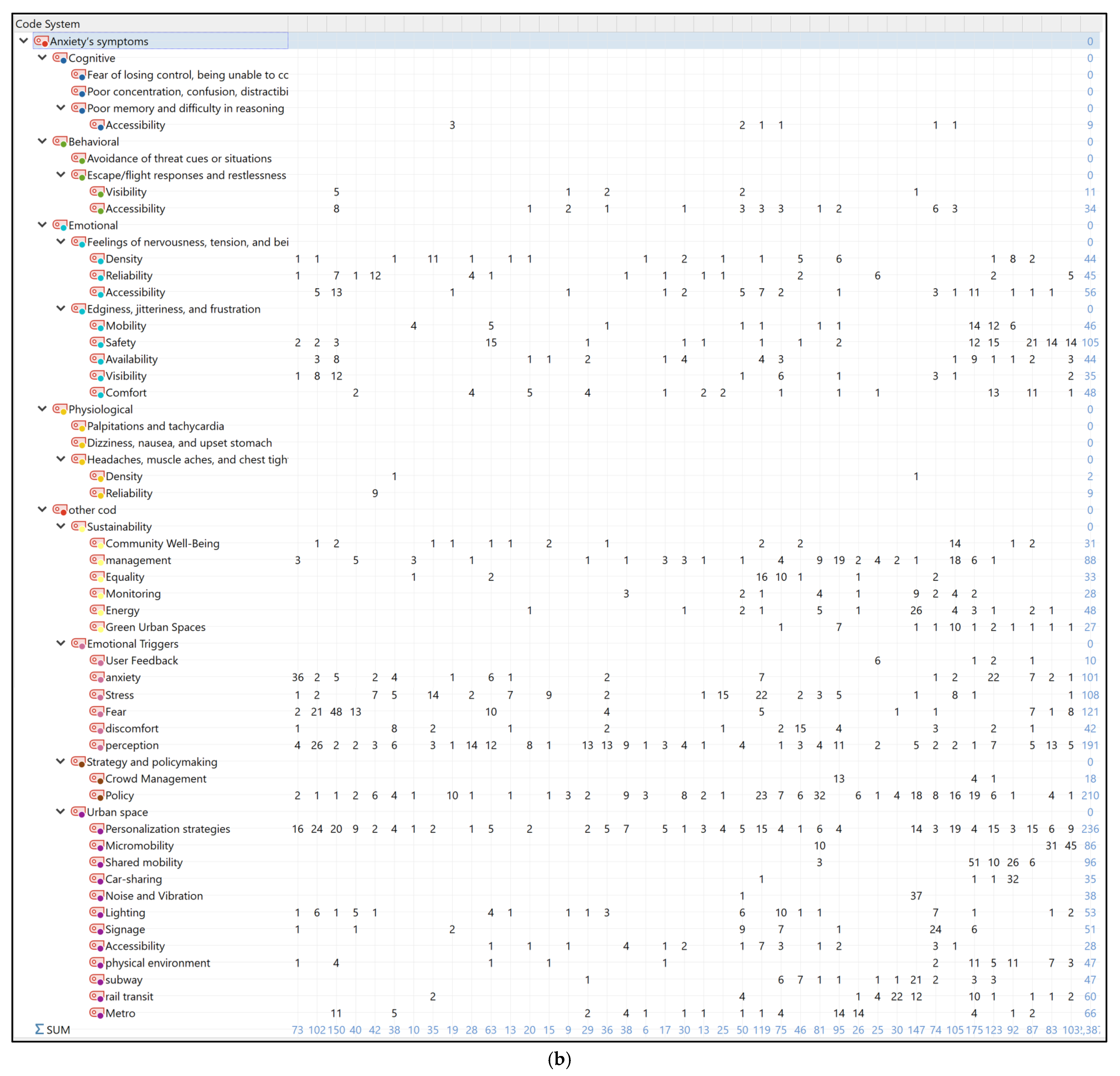
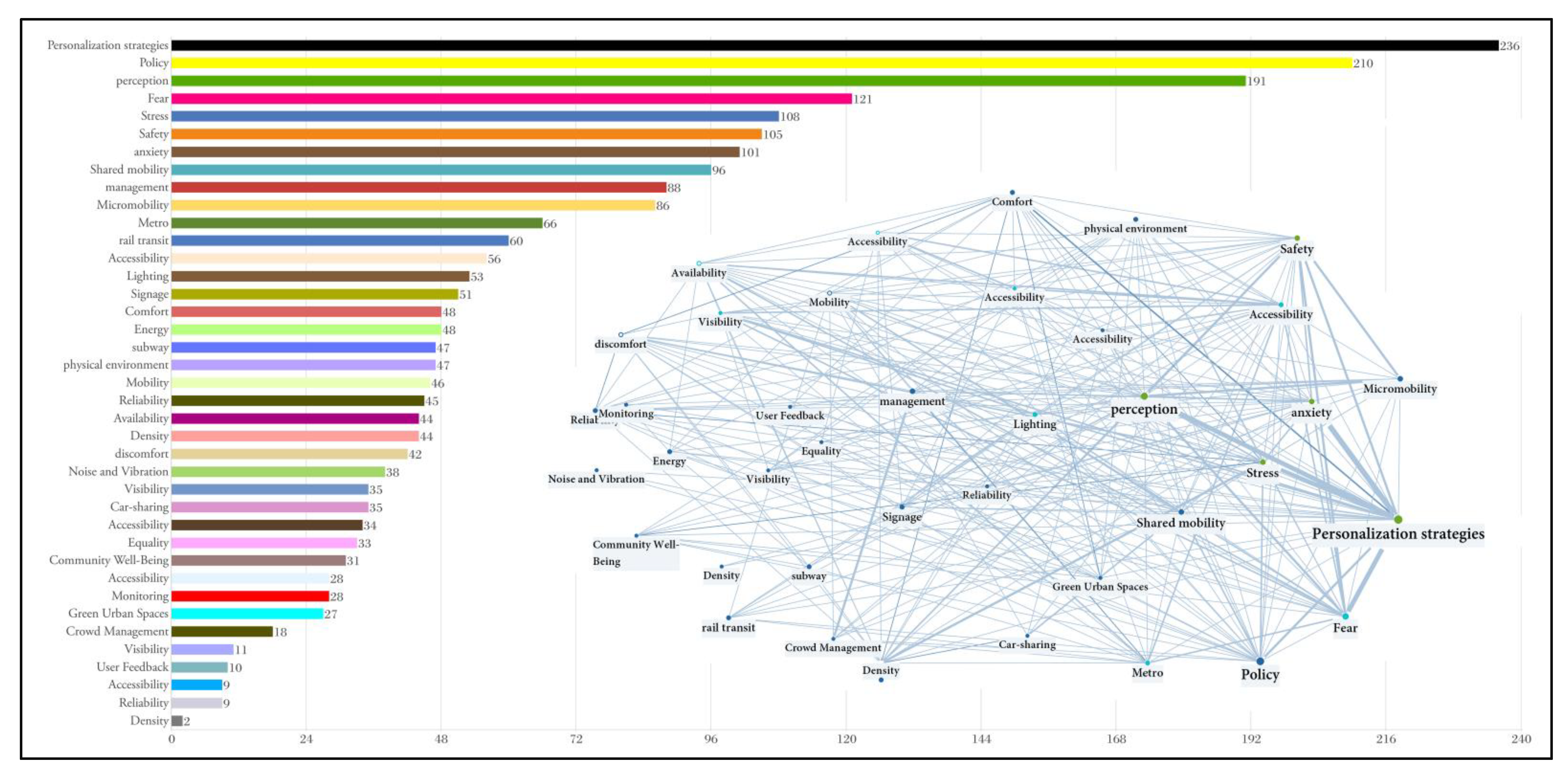

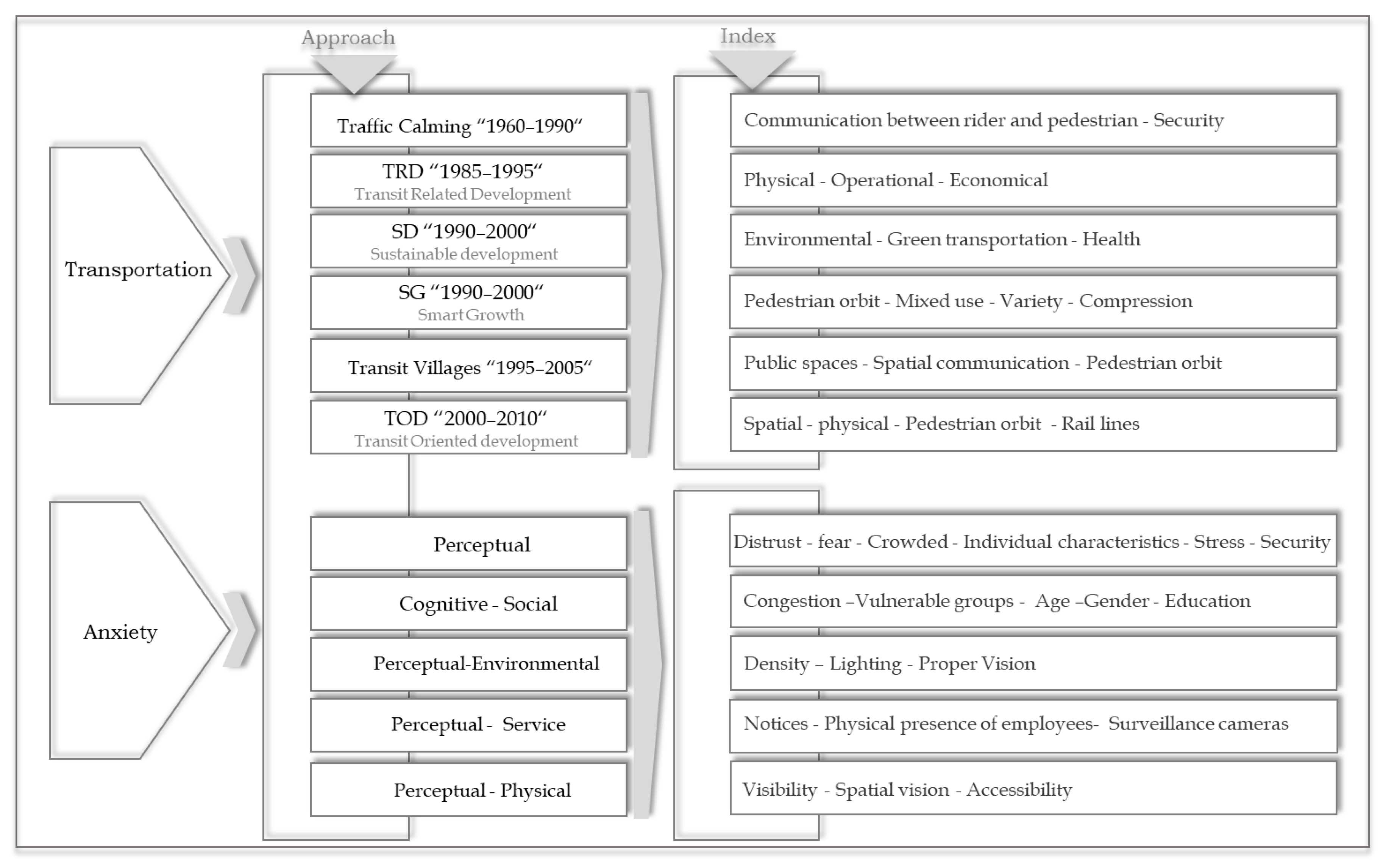


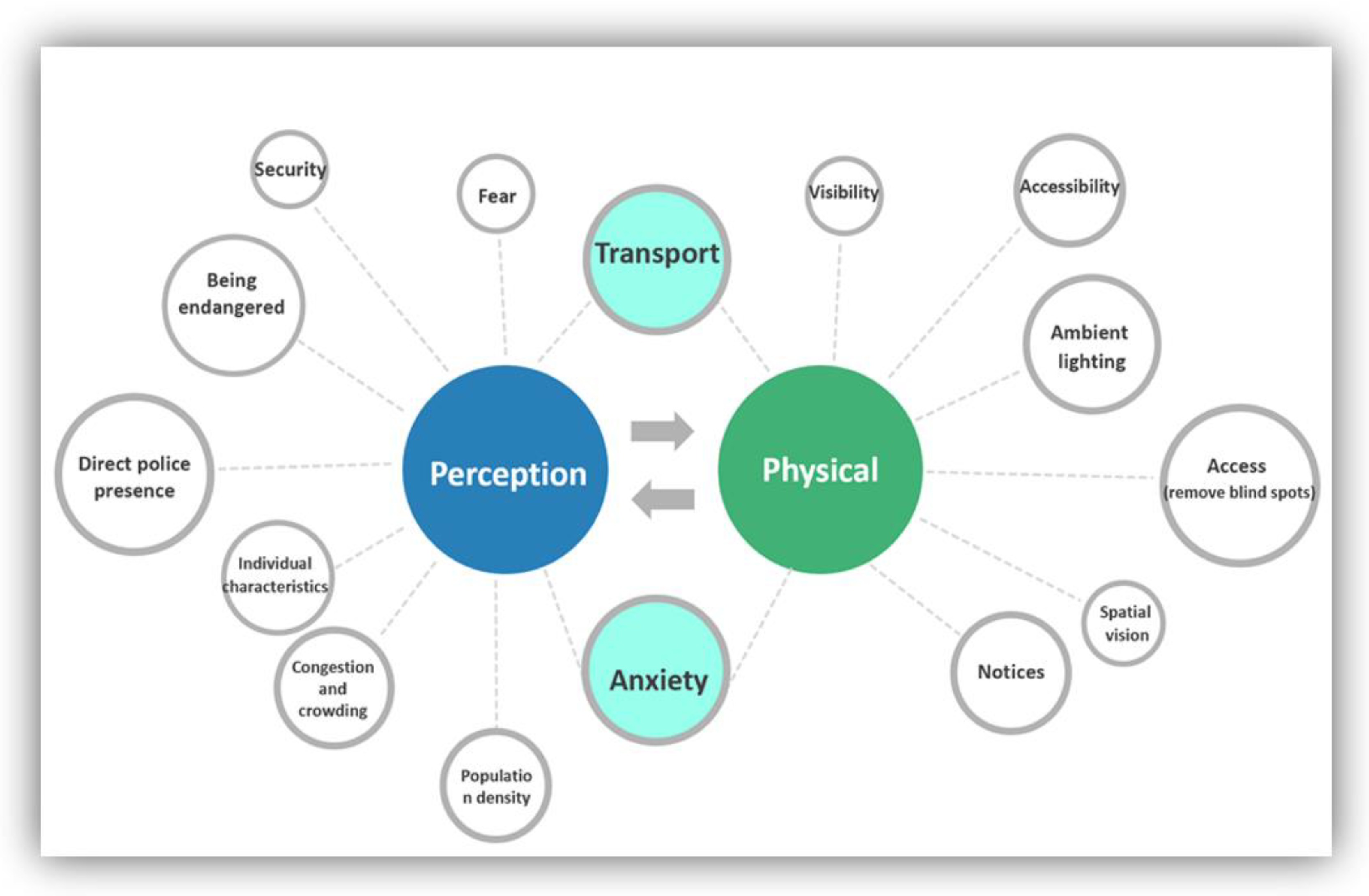
| Country | Objective | Actions | Source |
|---|---|---|---|
| Portland | The project evaluated the feasibility of implementing an electric vehicle (EV) car share as a sustainable, convenient, affordable, and reliable transportation option. | Improve transportation access. Educate the community. Use of electric vehicles in a way that benefits both individuals and the environment. | [76] |
| Cumbrian | The project seeks to enhance accessibility and foster inclusion in rail travel for individuals with disabilities and support needs. | Co-Designing Projects. Community Engagemen. Creative Initiatives. Accessibility Improvements. Feedback Mechanisms. | [77] |
| Sweden and Spain | Analyze and refine sustainable urban sharing initiatives, focusing specifically on Car Sharing Services (CSS) in Sweden and Spain. | Behavioral Economics Perspective Market and Environmental Analysis Stakeholder Interviews Experimental Design Policy Recommendations Geographical Focus | [73] |
| United States | This project aims to establish a resilient, future-ready transportation network in the United States. | Environmental Impact Assessment Raising Awareness and Support Stakeholder Engagement and Coordination Adapting to Changing Trends Utilizing Technology and Best Practices Public Awareness and Engagement | [78] |
| United States | This project aims to innovate and optimize public transit systems to meet growing mobility demands while reducing environmental impacts and enhancing operational efficiency. | Creative Solutions for Non-Car Mobility Marketing and Parking Support Flexible Support Structures Integration of Car-Sharing with Transit Services partnerships between car-sharing organizations and local governments or transit agencies. | [79] |
| Australia | The car-sharing services project aims to reduce resident vehicle ownership, thereby mitigating traffic congestion, alleviating parking scarcity, and enhancing urban mobility | Investment in Infrastructure Linking Car Share Services to Broader Goals Restricting Vehicle Fleet Growth Promoting Non-Car Ownership Lifestyles | [80] |
| California | This project seeks to alleviate sharing anxiety and bolster social acceptance of shared autonomous vehicles, thereby facilitating the transformation of public transport systems | Focus Groups and Stakeholder Interviews Development of the Societal Readiness Index Collaboration with Industry Partners Technical Interventions Data Collection and Health Monitoring Replicability Across Use Cases | [63] |
| Pacific Northwest (Alaska, Oregon, Washington, and Idaho) | This research project aims to analyze the patterns and drivers of micromobility in urban settings, particularly as cities respond to the disruptions caused by the COVID-19 crisis. | Infrastructure Development Integration with Public Transit Improved Signage and Lighting Community Engagement and Education Promotional Campaigns | [81] |
| India | The project’s main objective is to expedite the implementation of sustainable electric mobility systems in cities across India. | Encouraging E-Bike Usage Integration with Public Transport Promoting Sustainable Practices Establishing a Regulatory Framework Supporting Economic Opportunities Investment in Clean Vehicle Technology Government Initiatives and Policies | [82] |
| European Cities | Focusing on European urban settings, this project establishes a holistic framework to better understand and improve the management of shared micromobility, which is intended to optimize transport systems and encourage sustainable urban development. | Implementation of Infrastructure Adaptability in Urban Planning Regulatory Frameworks Monitoring and Evaluation Stakeholder Engagement | [83] |
| Symptom Category | Key Anxiety Symptoms | Associated Urban Transit Indicators | Sources | Comments/Key Findings |
|---|---|---|---|---|
| Cognitive | Fear of losing control and inability to cope |
| [84] | Cognitive symptoms are largely linked to perceptions of unequal service quality and limited access to necessary transit facilities |
| Poor concentration, confusion, and distractibility | ||||
| Poor memory and difficulty in reasoning | ||||
| Behavioral | Avoidance of threat cues and situations |
| [53,55] | Behavioral responses reflect challenges in spatial design, indicating that insufficient planning for emergency escape and clear spatial cues may prompt avoidance behaviors |
| Escape/flight responses and restlessness | ||||
| Emotional | Feelings of nervousness, tension, and being wound up |
| [15,45,46,47,51,53] | Emotional symptoms are exacerbated by environmental factors, such as lack of safety features and excessive crowding, that undermine users’ confidence in the transit system |
| Edginess, jitteriness, and frustration | ||||
| Physiological | Palpitations and tachycardia |
| [46,51] | Physiological manifestations are significantly associated with operational inefficiencies, such as service delays and overcrowding, that trigger somatic stress responses |
| Dizziness, nausea, and upset stomach | ||||
| Headaches, muscle aches, and chest tightness | ||||
| Other codes | Sustainability | Community Well-Being | [85] | Sustainable transport can address both environmental and psychological concerns in urban settings. |
| management | [85,86] | |||
| Equality | [87,88] | |||
| Monitoring | [85,89] | |||
| Energy | [85,89] | |||
| Green Urban Spaces | [85,86] | |||
| Emotional Triggers | User Feedback | [90] | Emotional triggers in transportation disrupt passengers’ sense of control and affect mental health. | |
| Anxiety | [15] | |||
| Stress | [45,87,91,92] | |||
| Fear | [47,53] | |||
| Perception | [47,93] | |||
| Discomfort | [51,94] | |||
| Strategy and policymaking | Crowd Management | [86] | Strategic policymaking in transportation can directly influence anxiety by shaping commuter experiences through the design of efficient, accessible, and reliable systems | |
| Policy | [84,87,89,95,96] | |||
| Urban space | Accessibility | [87,96] | Conversely, urban environments designed for active transport, like walking and cycling, can reduce stress and improve mental health | |
| Lighting | [88] | |||
| Signage | [97] | |||
| Noise and Vibration | [89] | |||
| Rail transit | [89,98] | |||
| Physical environment | [53] | |||
| Subway | [89] | |||
| Metro | [53,86,99] | |||
| Car-sharing | [57,66,68] | Emerging mobility solutions foster a resilient, user-centered urban transportation system. They address both psychological challenges and logistical barriers for rail transit users. | ||
| Shared mobility | [57,59,63] | |||
| Micromobility | [67,95,100] | |||
| Personalization strategies | [101,102,103,104] |
| Period | Theorist | Year | The Most Important Nuclear Categories | |
|---|---|---|---|---|
| Anxiety | Transportation | |||
| 1910–1860 | From the emergence of cities to 1860 | Fear and stress safety | The predominance of pedestrian movement | |
| - | 1880–1860 | crowded security | Relationship between the station and spatial performance Population development and the need for movement | |
| linear city | 1890–1880 | Physical components—accessibility needs-based | Increasing development around railway lines Use of new technologies in urban transport | |
| City garden | 1900–1890 | Physical components—accessibility Good peripheral vision | Avoid daily journeys Linking rail-based transport with the structural elements of Baghshahr Establish Letchworth and Welwyn centers close to the railway station | |
| Unlevel intersections | 1910–1900 | Security Crowded Congestion | Use of underground corridors, flyovers, and stairs for pedestrians Use of multi-level streets to separate different modes of transport | |
| Period | Theorist | Year | The Most Important Nuclear Categories | |
|---|---|---|---|---|
| Anxiety | Transportation | |||
| 1970–1930 | Public transport development circle (DOT) | 1930–1900 | Physical components—accessibility Congestion | Residential development around tram lines in the suburbs Increasing commercial use around tram stops |
| Spatial structure of a large city | 1970–1960 | Physical components—accessibility Ecological features | Recognition of the transport system and architecture of buildings according to the characteristics of modern transport Increasing the use of transport according to the body and function | |
| Design of environmental zones with traffic concept spatial vision | 1970–1960 | Spatial vision Physical components—accessibility confidence Notices | Increasing need to separate pedestrian and bicycle traffic Increased use of public transport Increasing quality, reliability and ease of access to public transport | |
| Period | Theorist | Year | The Most Important Nuclear Categories | |
|---|---|---|---|---|
| Anxiety | Transportation | |||
| 1980 until today | New Urbanism | 1980–1970 |
|
|
| Smart City | 2000–1990 |
|
| |
| Smart Transportation | 2000–1990 |
|
| |
| Transport-oriented development | 2010–2000 |
|
| |
Disclaimer/Publisher’s Note: The statements, opinions and data contained in all publications are solely those of the individual author(s) and contributor(s) and not of MDPI and/or the editor(s). MDPI and/or the editor(s) disclaim responsibility for any injury to people or property resulting from any ideas, methods, instructions or products referred to in the content. |
© 2025 by the authors. Licensee MDPI, Basel, Switzerland. This article is an open access article distributed under the terms and conditions of the Creative Commons Attribution (CC BY) license (https://creativecommons.org/licenses/by/4.0/).
Share and Cite
Hanaee, T.; Dincă, I.; Moradi, Z.; Sadegh Eghbali, P.; Boloor, A. Reflecting the Effect of Physical–Perceptual Components on Increasing the Anxiety of Inner-City Rail Transit’s Users: An Integrative Review. Sustainability 2025, 17, 3974. https://doi.org/10.3390/su17093974
Hanaee T, Dincă I, Moradi Z, Sadegh Eghbali P, Boloor A. Reflecting the Effect of Physical–Perceptual Components on Increasing the Anxiety of Inner-City Rail Transit’s Users: An Integrative Review. Sustainability. 2025; 17(9):3974. https://doi.org/10.3390/su17093974
Chicago/Turabian StyleHanaee, Toktam, Iulian Dincă, Zohreh Moradi, Parinaz Sadegh Eghbali, and Ali Boloor. 2025. "Reflecting the Effect of Physical–Perceptual Components on Increasing the Anxiety of Inner-City Rail Transit’s Users: An Integrative Review" Sustainability 17, no. 9: 3974. https://doi.org/10.3390/su17093974
APA StyleHanaee, T., Dincă, I., Moradi, Z., Sadegh Eghbali, P., & Boloor, A. (2025). Reflecting the Effect of Physical–Perceptual Components on Increasing the Anxiety of Inner-City Rail Transit’s Users: An Integrative Review. Sustainability, 17(9), 3974. https://doi.org/10.3390/su17093974







